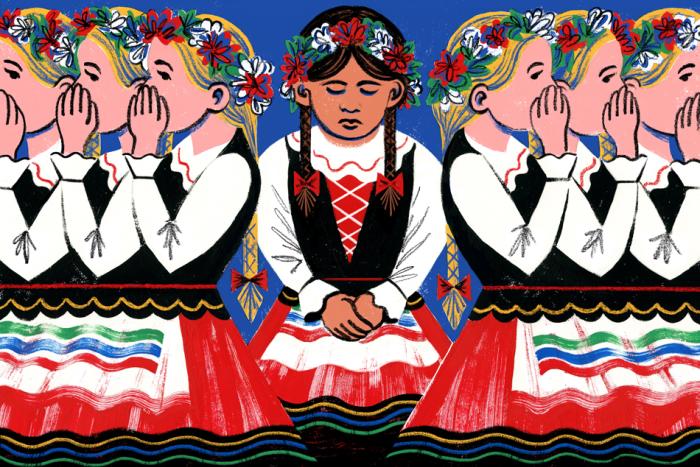Though he was hoping to see Rock Hudson or Doris Day on the street, Ismail Noor Muhammad Abdul Rahman didn’t see any stars when he first arrived in New York in 1958. The 21-year-old Indian man lived in a drab room on the sixteenth floor of Martinique Hotel in Manhattan’s Herald Square. The neighborhood was nothing like he pictured. Given the number of movies he’d seen featuring New York City, he was a naïve believer in the cliché that each street was paved with gold, so he was spooked by the sight of the homeless people who clung to liquor bottles.
Animal desire drove him to the city. On August 11, he boarded a boat that snaked its way from his native Bombay to Genoa, hopped on a train to London, and then flew to New York. He had finished his degree in political science and English literature at Bombay’s St. Xavier’s College, where he spent his last year applying to American business schools.
He was desperately hoping to gain admission to the University of Southern California, which would provide easy passage to Hollywood. Cinema was his great love in life, after all. The world would come to understand him in such terms when he re-christened himself Ismail Merchant, paired himself creatively and romantically with the Oregon-born James Ivory, and produced such films as A Room with a View (1986) and Howard’s End (1992) under the Merchant-Ivory label. These films trafficked in lush imagery, their moods carefully calibrated to convey the inner lives of characters who found themselves unmoored in the world and struggling to express their longings. Some films, like The Bostonians (1984) and Maurice (1987), came out in the thick of the AIDS epidemic and reckoned with queer desire.
He ended up going to New York University instead. It only took hours after arriving for the young man to wonder if he made a mistake in moving to the city. Most disorienting of all his new home had to offer was the food. He was puzzled by a place called Horn & Hardart, a clinical coin-operated food operation unlike anything he’d ever encountered. The sense of sterility extended to the grocery store, where all this food was sheathed in cellophane and he had to silence the impulse to touch and smell the food as he could in Bombay. He couldn’t make peace with the hot dogs and hamburgers in America. Not even the street food consoled him.
Maybe he should have foreseen this disappointment. The Bombay of his youth was a gastronomic wonderland, where bazaars felt like tactile museums: He could poke the poultry, sniff the melons, pinch the produce. He walked through Null Bazaar’s seafood stalls, made from marble slabs wobbling on wicker baskets. He gazed at the fruits and vegetables at Crawford Market as if they were jewels, filtered through forgiving skylights. He saw 20, sometimes 30 chickens cramped in straw baskets as they cawed and clucked, listening to their screams before slaughter.
The absence of refrigeration in his Bombay home meant that any meat was cooked the same day his family bought it home from the bazaar. Merchant didn’t do any of the cooking, though. The men of his middle-class, Muslim family were discouraged from entering the kitchen, primarily the domain of women like his mother and six sisters, though the hired help tended to be men.
Merchant relays these stories in two of his cookbooks, 1986’s Ismail Merchant’s Indian Cuisine and 1994’s Ismail Merchant’s Passionate Meals, both published well after he became an esteemed producer. America, Merchant explained in his cookbooks, was always the imagined destination. Once he had his business degree in hand, he found himself jobless, and he could only afford to eat meals from coffee shops like Chock Full O’Nuts. By then, he was trying to get financing for a short film, which would become 1961’s Oscar-nominated The Creation of a Woman. He needed a way to entertain his potential investors. The only way for him to survive was to learn how to cook.
In New York, he had the latitude to perform all the kitchen tasks he couldn’t in Bombay: cooking, serving, entertaining. Cooking came naturally to him. As if by osmosis, he’d unknowingly absorbed the lessons of his family’s cooks. He could make a simple dal or a keema of minced lamb and peas. These skills always lived inside him, awaiting articulation.
Cooking became a form of currency for Merchant, capital he used to ingratiate potential investors who could help finance his career in films. He knew it was odd for a would-be producer to feed investors himself rather than take them out to restaurants. But his food was a great equalizer. “I like to think that my cooking and the occasion softened some of them up a bit,” he wrote of his guests.
Merchant went on to achieve greatness in the culinary realm, making meals that had become legendary in their own right, particularly amongst the artists in his orbit. Actress and cookbook author Madhur Jaffrey called him “a shrewd horse-trader” in the foreword to his 1994 cookbook, a man who could “inject a sense of easy camaraderie between those high up in the entertainment establishment and those barely on the rise” through food. (Jaffrey, one of America’s doyennes of Indian food, has credited Merchant with kickstarting her culinary fame. He persuaded Craig Claiborne of the New York Times to write a 1966 piece on Jaffrey’s culinary talents in a bid to generate publicity for 1965’s Shakespeare Wallah, a film Merchant and Jaffrey worked on together.) “In India we say that the ability to create flavor is in the hands,” Jaffrey wrote. “Some people just have it. Ismail certainly does.”
In the kitchen, Merchant was a creature of instinct. Cooking was not a merely iterative process oriented towards producing a favorable result for him; it was an opportunity to experiment with abandon. Merchant’s greatest fear, he wrote in his second cookbook, was boring his guests with a static repertoire. “I disobey all the conventions and laws of cooking, preferring to improvise and make new discoveries all the time,” he wrote.
His recipes flaunted the rules he knew in Bombay. He tossed leftover lemons that were sitting in his refrigerator into his masoor dal. He cooked fresh ginger root and green chili into his burgers. He cooked shrimp in Dijon. The food was sly, giving convention a knowing glance before tilting it ever so slightly.
When Merchant wrote of his distaste for the rules that guarded cooking, he was, of course, referencing blind devotion to ingredients and techniques. Implicit in this statement of culinary rebellion, though, was his skirting of the rules of a world that told him that a cook must be a certain kind of person, must be a certain gender. On trips back to India, he tried his best to keep his culinary inclinations a secret from the women in his family, until he couldn’t hide it any longer. His mother became too sick to cook one day, so he prepared a meal of large prawns in mustard sauce in fewer than fifteen minutes.
His mother and sisters never quite got used to the idea of the family’s only son inhabiting the kitchen, though. It was as if he was committing an act of transgression, a man who took on a feminized trait and performed it.
There are codings in Merchant’s food writing that remind one of the unavoidable fact that Merchant himself was a gay man who was never publicly out, moving through spaces that could have very well been inhospitable to him had he been an openly gay man. Merchant died in 2005, at age 68, following surgery for abdominal ulcers. His widower, James Ivory, has recently stated in unambiguous terms what was once unspoken: The two men were in love.
In a 2018 interview with The Guardian, when pressed as to why he and Merchant dodged questions about the nature of their relationship, Ivory suggested that keeping them both in the closet was a shrewd way of protecting Merchant. “That is not something that an Indian Muslim would ever say publicly or in print. Ever!” Ivory told the paper of Merchant’s sexuality. “You have to remember that Ismail was an Indian citizen living in Bombay, with a deeply conservative Muslim family there. It’s not the sort of thing he was going to broadcast. Since we were so close and lived most of our lives together, I wasn’t about to undermine him.”
Understanding that Merchant maintained his public life in the closet shades his food writing with notes of queer desire, as if the kitchen gave him a chance to fulfill yearnings he had theretofore repressed. In these cookbooks, Merchant conjured a fantasy world, the kind some may associate with the prototypical domestic goddess. Merchant became the impresario who spun wonder out of groceries from Gristedes in the stuffy confines of 5 ½-by-8-foot kitchen equipped only with a four-ring gas stove and oven.
“A great cook should be able to do something well with the snap of a finger rather to toil over it,” he wrote in the introduction for his first cookbook. “He or she should be inventive, be someone who can whip up something from nothing.” A culinary wizard, to his mind, could practically assemble a salad from two strands of straw. Tucked in his recipe headnotes were the names of people most of us have only seen on celluloid: Maggie Smith, Christopher Reeve, Raquel Welch, Vanessa Redgrave. He summoned an existence a casual reader may dream of when standing inside their own kitchen.
The brand of domestic performance that Merchant perfected has long been coded as female. As writer Emily Gould noted in The Cut in 2017, the kitchen can cloister women as much as it can provide them a stage for expression. It follows, then, that when Merchant’s first cookbook was published in 1986, the most visible Indian cookbook authors in America were two women: the aforementioned Madhur Jaffrey and Julie Sahni, a dancer-turned-architect-turned-cookbook author who’d grown up in a Tamil Brahmin family.
Merchant published his first cookbook when America was finally disabusing itself of the notion that Indian food was too intricate to bring into the American kitchen. (Merchant’s first cookbook shows its age when it includes a recipe for fried paneer that calls for Cheddar cheese.) Both Jaffrey and Sahni had, the spring before the fall publication of Merchant’s first cookbook, published two cookbooks, A Taste of India and Classic Indian Vegetarian and Grain Cooking, respectively, illustrative of the point to which the genre of Indian cookbooks had grown.
But Merchant’s cookbook was not an Indian cookbook, per se; he certainly didn’t classify it as such. To start, he was operating from a different center of gravity than Hindu Indian food writers, having grown up in an Indian Muslim household who regularly consumed nonvegetarian food, thus disrupting the worn myth of the Indian national who is automatically vegetarian. More crucially, the cookbook is neither national nor regional in scope. Instead, as Craig Claiborne of the New York Times noted, it is “simply one man's inspired notion of what his native land's cookery should taste like. It is tailored to his own sophisticated and remarkably original palate.” Only Merchant could have written these recipes, in other words.
Sitting alongside this cultural history of women inverting the trap of the kitchen into a province of creativity is an obscured history of gay men pulling off a similar magic trick. The kitchen has long been an arena for expression for gay men, too, a tradition that food writer John Birdsall unwrapped in his 2013 piece for Lucky Peach, “America, Your Food Is So Gay.” Birdsall gestured towards a working definition of food shaped by gay men (Claiborne, one of the 20th century’s most influential culinary gatekeepers, was one). This was “food that takes pleasure seriously, as an end in itself, an assertion of politics or a human birthright, the product of culture.”
Birdsall wrote of his own impulses as a young line cook working in a casually homophobic San Francisco kitchen. He weathered prejudice routinely in these spaces, resulting in a fury that he soothed into spirited artistic output. He was “fueled by sublimated rage, the outsider with something to prove, taking the ingredients I was handed and making sure they transcended their limits.”
Merchant’s writing suggests a similar cognizance of the fact that his cooking possessed a whiff of radicalism, as if he was overcoming the boundaries others had set for him. His friends came to regard him as a master chef. He interpreted the compliment as a testament to his boundless imagination and fearlessness in execution, rooted in a desire to prove his own worth. In his eyes, as he wrote in his first cookbook, a master chef “must have imagination, a flair for mixing conventional and unconventional ingredients, an appreciation of different seasonings, and a desire to satisfy his or her ego.”
Today, some of the most prominent male voices in America who have written cookbooks borrowing tenets of Indian cooking—Nik Sharma, Suvir Saran, Raghavan Iyer—happen to be gay men, as if Merchant’s culinary spirit echoes in this current generation. Call it coincidence. (This is to say nothing of the queer women, like Preeti Mistry, who have written cookbooks.)
Reading Merchant’s gentle pleas to “be adventurous and not be afraid to make discoveries” in the kitchen brings to mind Sharma’s Season, the 2018 cookbook that brims with similar refrains. “Mine is the story of a gay immigrant, told through food,” Sharma writes, as if explicating what Merchant could communicate only in hushed tones. “It has been a journey of self-discovery I embarked on more than a decade ago, one that taught me to recognize the inherent tension between originality and tradition, and to opt for the former without rejecting the latter.”
Sharma’s is a philosophy that tosses curry leaves with the buttermilk batter for popcorn chicken; that grills pork chops with chaat masala; that puts paneer in places some may least expect to find it, like a salad of cauliflower and lentils. He, like Merchant before him, is guided by reverence to tradition without unwavering fealty to it. His is cooking that moves towards freedom, mindful of the worth of culinary tradition and carefully breaching it.
Merchant developed a vocabulary of cooking that was entirely his own long before these men, his queerness contained in whispers. He encouraged the curiosity that motivated him to take cooks places they may not otherwise have imagined. These recipes flowed from him freely, as if he was, in the kitchen, a man who had nothing to hide.






